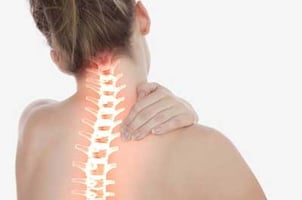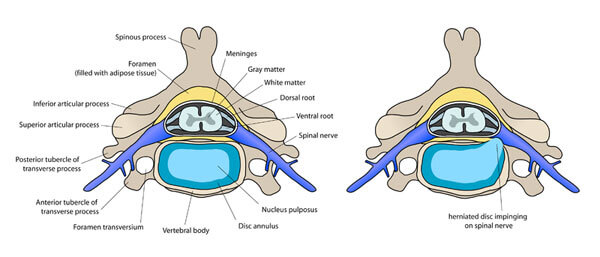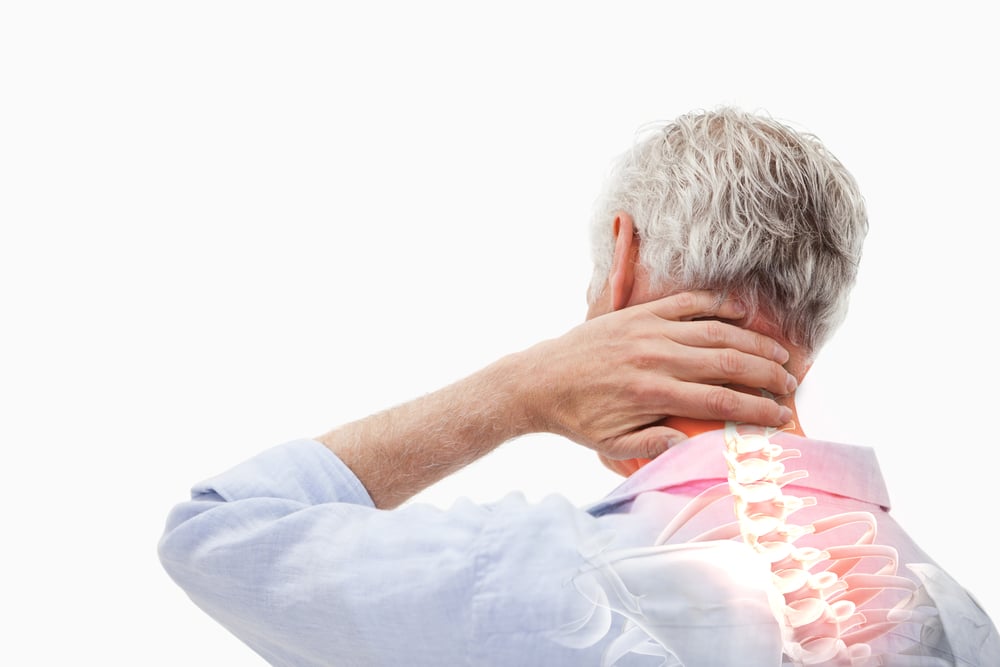Neck pain (also known as cervicalgia) is extremely common! At any given point, 30% of people have neck pain and 50% of people have some degree of chronicity of these symptoms.
That's quite a lot of neck pain! What a pain in the neck! (pun intended)
Those statistics mean we absolutely need to address neck pain but first we need to understand it's anatomy and where we can run into problems.
The neck is a very complex area, organized meticulously of muscles, nerves and joints. It gives rise to the nerves that control the arms and hands. Plus, it helps hold up our head! Imagine holding an 11 pound bowling ball up in the air all the time! That's the neck supporting our head. What an important job!
How exactly does our neck support our head?
 Our vertebrae (the bones of our spine) are intricately shaped to stack and articulate (fancy word for how they meet up/touch another bone) with one another. The joints in the cervical spine are called facets. The vertebral bodies are stacked on top of one another with the intervertebral disc between them. Imagine a jelly doughnut as the disc. The nucleous pulposus is the jelly filling and the anulus fibrosus is the actual doughnut portion on the outside. (By the way, discs don't slip! The nucleous pulposus can ooze out of the anulus fibrosus but the whole disc will not just slip out of the spine!)
Our vertebrae (the bones of our spine) are intricately shaped to stack and articulate (fancy word for how they meet up/touch another bone) with one another. The joints in the cervical spine are called facets. The vertebral bodies are stacked on top of one another with the intervertebral disc between them. Imagine a jelly doughnut as the disc. The nucleous pulposus is the jelly filling and the anulus fibrosus is the actual doughnut portion on the outside. (By the way, discs don't slip! The nucleous pulposus can ooze out of the anulus fibrosus but the whole disc will not just slip out of the spine!)
The big MVPs of course, are our muscles! There isn't just one or two muscles. There are layers and layers of muscles that stabilize, rotate, bend and extend the neck!
What muscles are in our neck?
Superficial: Trapezius (broken into 3 segments: upper, middle and lower), levator scapulae , sternocleidomastoid Intermediate: Splenius capitis, scalenes (anterior, middle, and posterior) Deep: Semispinalis capitis, rectus capitis major and minor, obliquus capitis inferior, longissimus capitis, multifidi (3 layers)
Woah thats a lot of muscles! And we can't forget the connective tissue which has fascial attachments all through the neck and spine. Any one of these soft tissue structures can develop tension or get "hung up".
The nervous system controls our muscles
Finally, our nervous system! Each spinal level has a nerve that exits from the spinal cord, named for that spinal level. For example at C5 (the fifth cervical, AKA neck, vertebrae), there is a left and a right C5 nerve root and a C5 spinal nerve.
The spinal nerves eventually branch off to form the brachial plexus (a huge network of nerves) and they continue to branch again where we get our peripheral nervous system! So there can be issues centrally at the nerve root or spinal nerve, or peripherally at a named nerve in the arm. Your physical therapist is able to help determine where there is an issue.
Many nervous system problems have overlapping symptoms so a detailed history is very important in diagnosing you correctly.
To make matters more confusing, muscles have referral patterns that can go up the neck and down the arm which is why your therapist will also do a thorough hands on exam in combination with the medical history.
Yet we don't always treat our neck as kindly as it deserves. We are all guilty of spending too much time bent over our phone, or working on a laptop for too many hours, or even sleeping on 5 pillows. Forward head posture is far too common these days! >Especially with so many individuals shifting to a work from home job environment, or virtual schooling. We hear time and time again that patients know their desk and computer set ups are not ideal but they continue with them anyways.
Improving your work environment
A few easy adjustments you can make to your work set up:
- Raise your computer monitor up so your eyes are level with the top 1/3 of the screen (If you have to use books or a telescoping stand).
- Rewind, start with shifting your lap top to a monitor.
- Take standing breaks, during calls is a great time, just make sure your monitor is positioned well.
- Utilize a headset instead of holding a phone pinched between your shoulder and ear
- Keep frequently referenced paper materials in an easy to see/reach spot so you aren't constantly twisting your neck, or bending down to pull them out of a drawer.
- Keep the ears roughly in line with the shoulders and the shoulder blades slightly rolled back. It shouldn't feel like you are standing stiff like a soldier, but opening your chest.
- Stop working in your bed! Monday mornings can be rough, but you're only going to make it harder on yourself if you're slouched in bed with too many pillows.
- Following these tips can help to minimize and even prevent forward head posture!
Which brings us to an important point in neck health: pillows
Why are pillows important?
It can feel like you are Goldilocks and the three bears trying to identify the best pillow for you. Some are super firm, others are really fluffy and compress down, others are gel memory foam. So many options. How they position you also depends on your mattress type. If you have a firm mattress with a firm pillow it might end up being too much cervical flexion (if you're laying on your back). Just as a softer mattress with a fluffy pillow might compress down too much and give you less support than you need.
Pillow positioning
Either way, your pillow should position you such that when you lay on your back, your face is parallel to the ceiling. We want to avoid tucking the chin. When you lay on your side your ear should be parallel to the ceiling. You don't want to have too much or too little support that your neck is side bent in either direction.
When you sleep on your side, trying to limit chin tucking (fetal position) is also important to keep in mind. Obviously once you fall asleep it's hard to manage your positioning, but at least attempting to go to bed in an ideal position will minimize the stiffness in the morning.
Keeping the pillow just under your head and neck is also important. Many patients get the pillow under their shoulders which pushes you into more flexion, which we are actively trying to avoid.
Avoid belly sleeping
You may notice we didn't talk about laying on your belly while you sleep. Because in order to do that, and typically still breathe, your head is rotated to the side in either direction. 7-8 hours of a rotated neck is going to spell out bad news for you.
If you must sleep on your belly, (and we hear it all the time, "I just have to sleep on my belly, I can't sleep any other way") there are a series of small pillows that can position your head and neck in a neutral position and still allow you to breathe. If you don't want to buy something fancy, you can use a hand towel to make a little forehead cushion, to lift your nose and mouth off the mattress enough to breath.
Goldilocks and the three pillows
Pillows are definitely trial and error, but eventually you will get to one that is not too hot, not too cold, but just right. When you do find one that works, buy a couple to keep in your closet and don't forget to bring it with you when you travel! Nothing is worse than sleeping badly and having neck pain while on vacation.
Your neck (and really your whole body) will thank you! You are doing this for your future self, in order to stay as active and healthy as you can be
Can we prevent all neck pain?
There are some dysfunctions to the neck that we can't always prevent from happening.
What causes neck and arm pain?
Remember that complex organization of bones, muscles and nerves that we talked about? Any of those structures can be injured or gradually deteriorate.

- Cervical radiculopathy is when the nerve root becomes impinged. (See the second image in the picture directly above where the disc is herniated and pressing on the spinal nerve)
- Cervical stenosis is as a result of the spinal canal narrowing.
- Cervical myelopathy is when the cervical stenosis becomes so severe that it is compressing the spinal cord.
- Muscle guarding which is when our muscles spasm to protect an area they feel like needs extra support. Sometimes they are correct, other times they aren't but generally they need help letting go.
What symptoms might I have?
- Neck pain
- Headaches
- Arm or hand pain
- Numbness and tingling in the arm or hand
- Arm or hand weakness (could drop items easily)
- Difficulty with fine motor tasks like buttons or writing
These symptoms may come and go, or stay constant. They can be provoked by different postures or activities, or even times of day. Many patients note more symptoms first thing in the morning and at the end of the day. Sometime it can feel like nothing consistently irritates your neck, but something as small as looking over your shoulder can throw it into spasm.
What can your physical therapist do to help?
- Manual therapy is a term that encompasses the soft tissue work that therapist use to help increase blood flow, decrease muscle and connective tissue restrictions, and decrease pain. They utilize strategies such as dry needling, cupping, massage, trigger point release, joint mobilizations and more to improve the length tension relationship of tissues.
- They will educate you on posture and movement strategies to help make activities of daily living easier. Just like the information about your desk set up and pillows, they can go over many different aspects of your life and problem solve with you.
- Physical therapists will help strengthen the arm and spine muscles to reduce strain on the neck and provide stabilization. As well as challenge sport specific muscle groups to keep you playing and exercising at your peak.
Neck pain and quality of life
Neck pain can be debilitating and significantly impact your quality of life as well as impact how you function. The best thing you can do for yourself is to stay active, be aware of your body positioning as much as you can, and address new symptoms ASAP. It is much easier to treat them, the less time has gone on. This isn't always the case of course, but a "wait and see" approach isn't better. At the very least, even if your body was going to heal completely on its own, we gave it a swift kick in the right direction.
Physical therapy for cervicalgia in Columbia and Baltimore, Maryland
If you have neck pain reach out to our office today!




